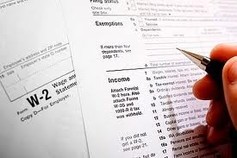Missing Your W-2? Here’s What to Do...
TAX TIP
It’s a good idea to have all your tax documents together before preparing your 2012 tax return. You will need your W-2, Wage and Tax Statement, which employers should send by the end of January. Give it two weeks to arrive by mail.
If you have not received your W-2, follow these three steps:
- Contact your employer first. Ask your employer – or former employer – to send your W-2 if it has not already been sent. Make sure your employer has your correct address.
- Contact the IRS. After February 14, you may call the IRS at 800-829-1040 if you have not yet received your W-2. Be prepared to provide your name, address, Social Security number
and phone number. You should also have the following information when you call:
• Your employer’s name, address and phone number;
• Your employment dates; and
• An estimate of your wages and federal income tax withheld in 2012, based upon your final pay stub or leave-and-earnings statement, if available. - File your return on time. You should still file your tax return on or before April 15, 2013, even if you have not yet received your W-2. Your tax preparer will
assist you in filing the proper form to estimate your income and withholding taxes as accurately as possible.
If you receive the missing W-2 after filing your tax return and the information on the W-2 is different from what you reported, contact a tax professional to assist you you with correcting the incorrect information by filing an amended return.
-Yarbrough's Tax & Consulting Firm
Eight Tax-Time Errors to Avoid
If you make a mistake on your tax return, it usually takes the IRS longer to process it. The IRS may have to contact you about that mistake before your return is processed. This will delay the receipt of your tax refund.
The IRS reminds filers that e-filing their tax return greatly lowers the chance of errors. In fact, taxpayers are about twenty times more likely to make a mistake on their return if they file a paper return instead of e-filing their return.
Here are eight common errors to avoid.
1. Wrong or missing Social Security numbers. Be sure you enter SSNs for yourself and others on your tax return exactly as they are on the Social Security cards.
2. Names wrong or misspelled. Be sure you enter names of all individuals on your tax return exactly as they are on their Social Security cards.
3. Filing status errors. Choose the right filing status. There are five filing statuses: Single, Married Filing Jointly, Married Filing Separately, Head of Household and Qualifying Widow(er) With Dependent Child. See Publication 501, Exemptions, Standard Deduction and Filing Information, to help you choose the right one. E-filing your tax return will also help you choose the right filing status.
4. Math mistakes. If you file a paper tax return, double check the math. If you e-file, the software does the math for you. For example, if your Social Security benefits are taxable, check to ensure you figured the taxable portion correctly.
5. Errors in figuring credits, deductions. Take your time and read the instructions in your tax booklet carefully. Many filers make mistakes figuring their Earned Income Tax Credit, Child and Dependent Care Credit and the standard deduction. For example, if you are age 65 or older or blind check to make sure you claim the correct, larger standard deduction amount.
6. Wrong bank account numbers. Direct deposit is the fast, easy and safe way to receive your tax refund. Make sure you enter your bank routing and account numbers correctly.
7. Forms not signed, dated. An unsigned tax return is like an unsigned check – it’s invalid. Remember both spouses must sign a joint return.
8. Electronic signature errors. If you e-file your tax return, you will sign the return electronically using a Personal Identification Number. For security purposes, the software will ask you to enter the Adjusted Gross Income from your originally-filed 2011 federal tax return. Do not use the AGI amount from an amended 2011 return or an AGI provided to you if the IRS corrected your return. You may also use last year's PIN if you e-filed last year and remember your PIN.



